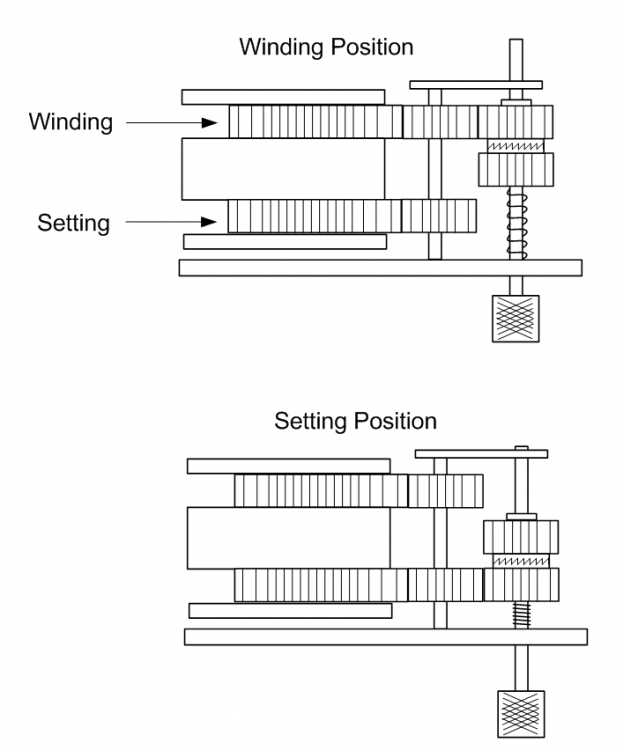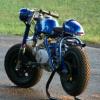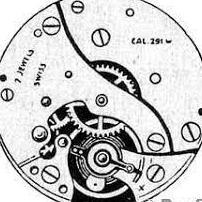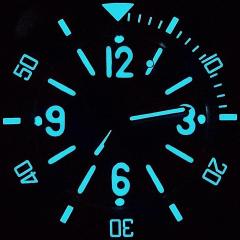Leaderboard
Popular Content
Showing content with the highest reputation on 11/01/22 in all areas
-
Nothing beyond that. I had used mine for cannon pinions, but had never removed a jewel, reamed a hole, replaced a jewel. So, it was useful to practice this with knowledgeable instructors around.3 points
-
Here's one way I check the train of wheels. With just the train installed, no mainspring barrel and no pallet fork, I use my puffer to gently blow air at the escape wheel. The escape wheel should take off and spin vigorously. Then, I put the mainspring barrel in, and do the same. This time, the escape wheel should "bounce" off the resistance of the mainspring barrel, and then run the other direction a bit. This I call recoil, I've heard other terms used to describe the bounce. Once you've done this with a few watches you'll get a feel for what the train should do. Cheers!2 points
-
from the videos it looks to me like the balance wheel is right doesn't look like the arms are bent in. Doesn't mean they couldn't be bent out a just a tiny bit if we really had to. Not quite sure what I think about the hairspring. Then a note regarding the hairspring you do want to make sure when you look inside ways that the over coil isn't touching the upper bridge sometimes that happens that would make you run fast. Also make sure they hairspring is flat not touching the balance arms another reason why had run fast then the timing machine was what I was looking for it be nice if you had one crown down though. Because at least with the timing machine we have something to work with we know you're running fast. We know the amplitude is bad you probably haven't cleaned and lubricated things properly and or replace the mainspring which is probably cents. Then hairspring photo that was bothering me? it was on the other page you might a fixed it already it's hard to tell in the pictures on this page does are not sharp enough. You notice I snipped out the center part it looks like in that image they hairspring comes out from the pinning point and dips back EN and may be touches the collet if so that would be why you're running fast then do you have a demagnetizer? I'm pretty sure that's a steel hairspring and magnetized hairsprings also have issues.2 points
-
Yes you do need to have the bridge on. The reversing of the escape wheel is good to see and does indicate a free running of the train but i dont get too bothered about it,some things you can live with if the watch runs ok on your wrist unless the amplitude or reserve is low. In which case i would go back to investigate. You could check each train wheel individually for excessive sideshake and end shake a bit time consuming but necessary if you are going through the process of elimination. I meant i start with the barrel checking its components for visual wear then its side and end shake with its bridge on. And then install the train checking all the pivots thoroughly , then how well they run together with their bridge on. At this point you would be looking for a reverse of the escape wheel by adding a few winds on the barrel. Oooh nasty.2 points
-
The local chapter of NAWCC jointly with CAWCG (affiliate of AWCI) held a class on staking and jeweling today...just 30 minutes away! It was great. I had never used my Seitz jeweling tool for anything other than tightening a cannon pinion. It was fun...and a new vista!! Great bunch of guys too.1 point
-
The stem is in, this is not a hand winding movement so i think it's irrelevent whether the stem is in. I did as in the original video i posted use a screwdriver to manually wind the barrel. ALso the top pivot of my 3rd wheel looked....odd once i pulled it out. THe actual pivot itself looked fine but the area it's joined to the wheel looked like it was almost sunk in compared to another one i had on hand. I swapped them and i'm putting it back together now. One thing that was weird befor ei took it together i was watching how Mark tests his wheel train, I noticed he was able to with ease turn the center wheel both directions and spin it clockwise with ease. I can only move it one direction for some reason and I don't know why. I examined all my wheels and the pivots look fine other than that thing with the 3rd wheel. Why would he be able to spin his 4th wheel both directions but i can't? Everything seems to be engaging fine, everything is in their pivots. https://youtu.be/tDa1ZZFwoBU?t=1350 EDIT: Ok now things are spinning more like i would expect from that video. sweet. I may have had a busted 3rd wheel before... Ey this is workin now! Might have had an out of spec or deformed 3rd wheel. Swapped it out and everything seems to be as expected now.1 point
-
1 point
-
I can see that my comments may conflict Colin, my repairs are 95 % vintage swiss. I've never used an auto oiler , i always disassemble and use a basic oiler. Fresh oil will have viscosity as opposed to no oil has no viscosity.if you can imagine you are in a way contaminating a pivot in its jewel hole. This is why after a service amplitude can be quite low but pick up after a few hours sometimes days as the oil reaches its running viscosity.1 point
-
I would normally lubricate after the movement was fully assembled.1 point
-
If you click through to the website, it's all about snoring1 point
-
That test is typically made before oiling. With oil in the jewels you cannot expect that reversal to happen in any case. Frank1 point
-
I believe the bearing under that cap jewel is typically the conical sort. The jewel isn't actually in contact with anything that moves. In (some year someone will know and chime in with off the top of their head) there was some sort of industry standard/agreement/something set where any jewels proclaimed on the dial had to be functional in one of a list of ways. Prior to that, you had 100 jewel watches where most of them were just inlaid around the perimeter of the movement to boost the jewel count. This is one of those. The jewels themselves are cheap, it's the precision that's expensive. Dropping one into a prominent position that looks like it might do something allows the manufacturer to say "jeweled" on the dial (even though "bedazzled" might be more accurate) without lying. The casual observer, knowing nothing about how watches actually works, might look and see the jewel in the middle of the fast moving part, and conclude that it's contributing somehow. In summation; no. Just marketing.1 point
-
Unfortunately I don't have a hot plate, and I don't think the wife would be too happy about me running experiments on the stove. Boy oh boy did I hear it when I tried to make a nickel plating solution under our stove's fume hood.1 point
-
I don't think you can infer a date from the case back serial numbers on Raketa watches. There are some subtle design changes in the mechanisms over the years, and also the later Russian mechanical watches may say Russia rather than USSR on the dial, putting them post 1991/2. As I recall there are some of the scanned Raketa catalogues on line (which I can't find right now) and a few USSR era watch sites and forums (some in Russian). Here for example -> https://www.russian-watches.info/category/raketa-watches/ There is also a site that deals with the modern stuff (post 2010) here -> https://www.raketawatchclub.com/catalogs Lock your wallet in a drawer before you look at those sites, there are some tempting items there.1 point
-
first step with any problem is, is this actually the problem? In other words when the balance wheels in the watch and it's spinning does it look like the arms or where there supposed to be. There's no point in bending them out if they seem to be right. then bending them isn't really a problem if there is a problem providing somebody just squeeze the balance wheel and didn't get creative. If it was just a simple arms bent in sometimes I bend it out with my fingers other times there's a special tool because sometimes you want to be very specific where you do the bending. But for right now let's just see if it really is the issue because there's something I saw on one of your images is bothering me then as the balance wheels out of the watch you get a really sharp image of the hairspring looking straight down. then I went back through all of your posts from the beginning and looked at the pictures and videos and not sure how helpful but was more like concerns. Then because I was trying to grass where we currently are I read all your messages on the previous page and I have questions. As I see you have a Chinese 1000 timing machine how about giving us some pictures of the watch on the machine so we can see what it looks like. I have concerns. But rather than telling you the concerns I like to just take a step back and look at the big picture what's going on with the watch. being curious about that I went to the usual link below and no mean time screws. Then as I suspected the watches gone through a lot of evolutions and variations. Also looking online to see if I can find additional balance wheels to look at that becomes problematic due to the variations of the watch. Which is why we can seemingly see other balance wheels like in this discussion whether different supposedly the same watch where they're not actually the same watch. Did find somebody it had one entirely disassembled and the picture was online it looks like the exact same movement and I got a nice image of the hairspring from that. So at least you can see where the Olivera coil is supposed to be. http://www.ranfft.de/cgi-bin/bidfun-db.cgi?10&ranfft&0&2uswk&Omega_30_21 point
-
I also do it this way. Apply oil to underside of hole jewel, then poke it through. I use a single whisker that I snipped off my dog's muzzle. Not kidding.1 point
-
Looks like a fail to me. Check the barrel isn't rubbing on one of the plates, and check all the end-shakes in the train.1 point
-
Do you have a link to the checklist? EDIT: I found it. The part in question. e. Wind watch slightly to check kick-back and recoil. This check should be made in dial up and dial down positions. If the watch does not have kick¬back, this indicates that the train is not as free as it should be. First, however, before checking into the train itself to determine if there is some frictional error, it would be worthwhile to examine the mainspring around the barrel arbor. Many times the loose fit of the mainspring around the arbor will prevent kick-back from occurring within the train. In such instances, the arbor is simply slipped in the mainspring instead of the train receiving the reversal torque, that normally occurs. If the barrel is found to be satisfactory, then the train. should be checked to see if the trouble can be located. first, the train should be examined carefully to see if each wheel is free, and if no trouble can be found, then it is advisable to remove the train wheels from the watch and replace each wheel in the watch individually and to check the spin of each wheel. If each wheel spins freely, this indicates that the pivots and the jewels are in good condition and that one need not look further for defects or faults in those areas. Next, place two wheels at a time in the watch and check the spin of the wheels. Thus, any error of improper depthing or a badly formed tooth on a wheel or pinion will be detected. It is simply a process of elimination in order to locate the particular trouble, and of course, proper corrective measures must be taken to correct an error when one is found. It sounds like what you're doing is correct, but I've never seen this before. Will wait for someone with more experience to chime in.1 point
-
if it was an original Rolex balance staff everything should be perfect. But this is watch repair and things tend to end up not being perfect for variety of reasons. Especially as the watch gets older there was more likelihood of basically somebody had a bad day and there's going to be an issue. So basically if you replace the balance staff wheel you're supposed to putting it in truing calipers and make sure that its flat. But it depends on how obsessed you are with doing that. Things can look really flat in the truing calipers but in the watch they may not look as flat. then of course there still could be something else going on.1 point
-
It's even easier to do damage, and the effect is worse, if the inadvertent sqeezing occurs at 1 and 5 o'clock.1 point
-
Apollo 14 the "Moon tree" flight. It arguably included some of the most interesting science done on the moon during the Apollo program. https://en.wikipedia.org/wiki/Apollo_141 point
-
so this is a problem you should be resting on one of the pins. With an over coil hairspring the regulator pins are supposed to be as tight as possible but still allow the Springs slide. So in other words if you look in you really shouldn't feel the tell if it's resting on either pin it should be between the pins I eat but still allow it to slide you don't what it punching up when you move the regulator that's very bad. Flash hairspring is need I don't know what they call up breathing room and do you do have to have a little bit again. bad wording on my part.Look at your balance wheel look at the rim not the arms is supposed to have a perfect circle but you have a bimetallic balance wheel which with temperature the arms themselves will move in and out or basically the outer circle will move in and out a little bit. If somebody squeezes the balance wheel which is very easy to do the arms will move in just a hair and that will screw up your timekeeping. An example of that is I had a pocket watch once that everything looked perfect but it was way too fast and the arms look like they were in the right place but I just moved both of them out just almost basically not even noticeable and the watch was exactly on time it was only because the arms had been squeezed.1 point
-
Once you have your degauser, time to actually calibrate your caesium clock(s).1 point
-
My money is on glue. More specifically, hide glue. Predates a lot of the modern glues, used to be very common, works with metals (and even glass), dries hard and crystalline/glasslike, slightly brown (like caramel) if it's thick enough, pretty much clear if it's thin, and is acidic (would leach copper from the brass). It is water soluble (you'd have to crunch it up into small pieces/granules, and it'll take a while), and melts at... 180*(? I have a pot for hide glue for luthiery that just gets to the correct temperature without me having to remember...) for reworking. It has a distinct smell, but if it's old it might not smell much unless it's melted down and reset.1 point
-
Spent many years in the lube industry and oils degrade due to ;- Air - oxygen in air will slowly oxidise elements of the oil - remedy is to keep airtight. Best done by storing upside down so lid is sealed by the oil. Less free space the better. Heat - this will evaporate any light ends and cause the oil to thicken. Usually not a problem in watches c.f. engines. Keep as cool as possible, some people keep in fridge, but not freezer. Moisture - akin to air. All oil and greases contain minute quantities of water which will abet oxidation. Water will often degrade additives. Keep as dry as possible and avoid open containers in high humidity conditions. Again store upside down to seal lid as the free space will 'breath' air in and out as temps/humidity vary Light - this will slowly oxidise oil, so keep in the dark. Storage medium - glass is best, avoid metals as these may consume some additives (that is their job!) and plastic may leach into oil in some cases. Basically store upside down, in the dark in a cool dry environment with the lid firmly closed. This is more important with natural oils/greases. Some 'synthetic' oils are 'synthesised hydrocarbons (SHC)' and some are in fact not 'oils' but chemicals. Shelf life is a debatable topic. If oils/greases are stored in the best conditions as above they should last many years, more so with SHC types. Similarly watches that are tightly sealed should see less oil degradation, more so if they are assembled in clean, low humidity conditions. Just my opinions from my experience.1 point
-
Auto Forward/Reverse is now a reality. https://vk.com/video617204413_456239029?t=5s https://vk.com/video617204413_456239030?t=10s https://vk.com/video617204413_456239031?t=6s It works a little differently, flip the switch up to reverse and it auto for/rev, flip it down to forward CW rotation only to spin off the fluids. everything else works as it did before see the videos.1 point










